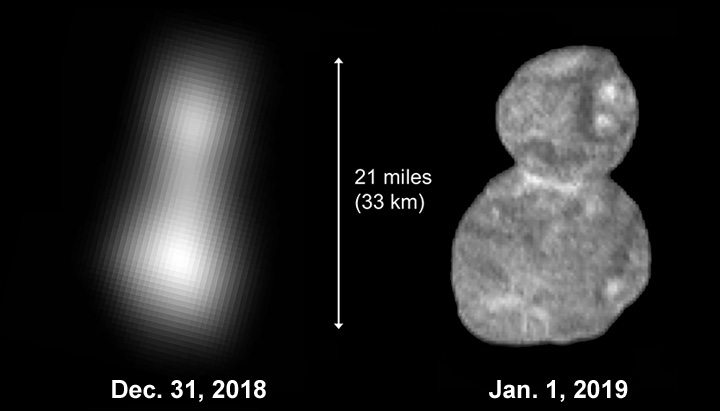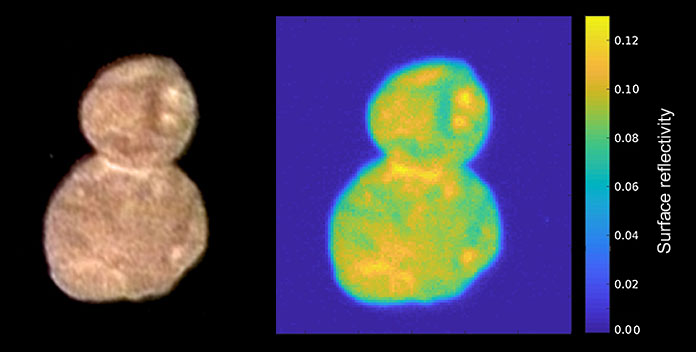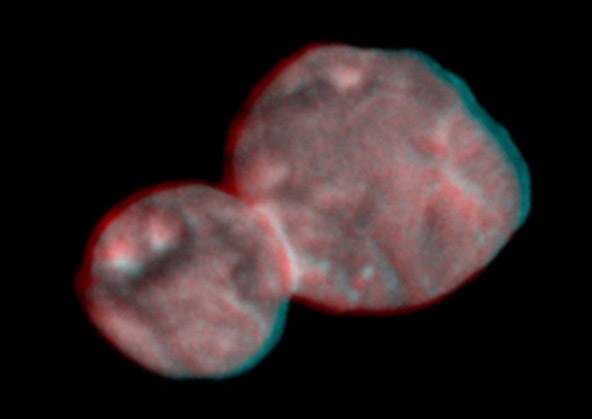Images and other observations taken by the New Horizons spacecraft early on New Year's Day reveal a remarkable (but not unexpected) two-lobed object.
Ever since NASA's New Horizons made its triumphant sweep through the Pluto system 3½ years ago, mission scientists have eagerly awaited the craft's arrival at its next destination: the Kuiper Belt object designated 2014 MU69 but better known as "Ultima Thule," the informal nickname (meaning "beyond the known world") adopted by mission scientists.

NASA/ JHU-APL / SwRI
That encounter occurred in the first hours of 2019, and in the four days since the spacecraft has raced another 5 million kilometers (3½ million miles) from Earth along its never-to-return trajectory. In that time the slow but steady trickle of observations beamed to Earth by a 15-watt transmitter have both stunned and elated the mission's scientists. Those results have morphed 2014 MU69 from a 26th-magnitude blip barely observable by the Hubble Space Telescope into a tiny, colorful, intriguingly detailed world.
Actually, it's two roundish worlds nestled against one another, termed a contact binary, with one lobe somewhat larger than the other and a combined length of 33 km (21 miles). Images released by the mission team so far, which show details as small as 140 meters (450 feet) across, show that the lobes are both dark, slightly reddish, and mottled with brighter and darker markings.
This two-lobed "snowman" appearance wasn't unexpected — that shape had been inferred from a challenging but successful ground-based effort to record the object's passage in front of a star in July 2017. Moreover, astronomers now suspect that roughly a third of 100-km-size objects in the "classical" Kuiper Belt are also binaries. These objects are dynamically "cold" — their roughly circular, low-inclination orbits are 40 to 50 astronomical units from the Sun and oriented much like the planets'. Some of these binaries are likely two halves joined together, while others are separate, similar-sized spheres closely orbiting one another.
Still, "suspecting" isn't "knowing," and the spacecraft's flyby of 2014 MU69 offers planetary scientists a game-changing view of what happened when our solar system formed 4½ billion years ago. Dynamicists suspect that this a body that formed directly in the frigid fringe of the solar nebula and has remained largely unchanged ever since.
Remarkably, this object became New Horizons' post-Pluto target simply because it could be reached by the spacecraft. But as principal investigator Alan Stern notes, "I'm surprised that by picking just one Kuiper Belt object out the hat, we were able to get such a winner as this."
Twinned Target
The larger globe of 2014 MU69 has roughly three times the volume of its companion. (The mission team has dubbed them Ultima and Thule, respectively, to remember which is which.) They probably consist primarily of ice, but their surfaces are actually quite dark, reflecting between 6% and 13% of the weak sunlight striking them. The reddish hue, thought to arise from complex organic compounds irradiated by space radiation for eons, matches that of other low-inclination Kuiper Belt objects.
But the narrow "neck" joining the two globes is telling a different story. It's both the brightest and the least red of the surface seen so far. According to Jeff Moore (NASA-Ames), this could mean that the neck ha a different composition. Or perhaps it's where small particles have "rolled" down steep slopes toward the object's center of mass.

NASA / JHU-APL / SwRI
Although initially uncertain, two lobes rotate around in roughly 15 hours. This relatively slow spin doesn't create nearly enough centripetal force to fling them apart. They're "soundly bound" in a structural sense, notes Moore, though they're essentially "resting on each other."
Meanwhile, the spacecraft's ultraviolet spectrometer has been searching for any wisps of gas nearby, and its cameras have been searching for small moons or hints of rings. No one expects such a small object to have an atmosphere, but the lack of moons is something of a disappointment. As co-investigator Mark Showalter (SETI Institute) notes, "Any moon at all, on any orbit at all, will tell us the mass and density" of 2014 MU69.

NASA / JHU-APL / SwRI
Beginning today, through January 7th, New Horizons' line-of-sight direction will be too close to the Sun for reliable radio transmissions, but they'll resume later next week. Still to come are observations taken when the spacecraft passed closest, at a distance of just 3,535 km (2,195 miles).
Buried among those are a series of images taken by the Long Range Reconnaissance Imager (LORRI), essentially a 20-cm f/13 telescope not unlike what you might use for stargazing in your backyard. Stern is "guardedly optimistic" that, when those views reach the ground late next month, they'll reveal details on the two lobes' surfaces down to about 17 m (55 feet) across.
 8
8









Comments
tom-dasilva
January 4, 2019 at 3:06 pm
Struck it rich with the first detailed images of a Kuiper Belt object. Imagining what exactly happens to create a contact binary is fun. Lots of scraping seems likely.
You must be logged in to post a comment.
Frank-ReedNavigation.com
January 4, 2019 at 8:05 pm
From the article:
"better known as "Ultima Thule," the informal nickname (meaning "beyond the known world") coined by mission scientists."
They didn't quite coin it, of course. They "borrowed" an ancient coinage. It's a geographic expression for a place in the far north which later became a poetic name for a distant, mysterious, icy place --like a Shangri-La but with winter sports. The Roman poet Virgil is usually credited as the author who "coined" the expression "Ultima Thule" about 2,047 years ago. For many centuries in English literature and geography, the name was attached to Iceland... It's a good name for an icy world on the fringe of the Solar System, and it's an apt nickname for the red snowman...
You must be logged in to post a comment.
Lady1209
January 4, 2019 at 8:39 pm
"Red Snowman"...too cute
You must be logged in to post a comment.
J. Kelly BeattyPost Author
January 5, 2019 at 8:00 pm
Frank, I can always count on you to keep me honest. how about my switch to "adopted"?
You must be logged in to post a comment.
Frank-ReedNavigation.com
January 6, 2019 at 2:11 pm
Heh. It was just fine the way it was. I neglected to add in my little "history" how many of "us" first encountered this name some forty years ago. Any among us who were nerdy teens back then (like me) probably first heard the name in an episode of the melodramatic space opera "Space 1999". The planet of Ultima Thule was an icy wasteland, of course, and that's why the script writer made this "literate" reference to the old name. I remember back then being intrigued by the name and looking up "Ultima Thule" at the library. That was when I discovered there was a Roman called Virgil... And that's when I learned that the great explorer Richard F. Burton had written a book about his travels in Iceland (a century before that sci-fi episode) entitled "Ultima Thule". I do wonder which was more important in attaching the name to this small Kuiper Belt object: was it Roman poetry and 19th century literature? Or was it an episode of a space opera in the 1970s? It all works.
You must be logged in to post a comment.
StanR
January 5, 2019 at 12:44 am
Are there any more possible known destinations for New Horizons, or is this the last one?
You must be logged in to post a comment.
J. Kelly BeattyPost Author
January 5, 2019 at 5:15 pm
There's enough propellant for a delta-V of about 70 m/s, about what was required after Pluto to redirect to 2014 MU69. assuming the mission is extended, the team has a couple of years to find another target along the exit path. but it'll be tough: this area is dense with milky Way disk stars, and the objects will get progressively dimmer. there's a chance that the James Webb telescope, once launched in March 2021, will join the search.
You must be logged in to post a comment.
Peter Wilson
January 8, 2019 at 10:37 am
How about Pen Ultima and Ultima Thule?
You must be logged in to post a comment.
You must be logged in to post a comment.